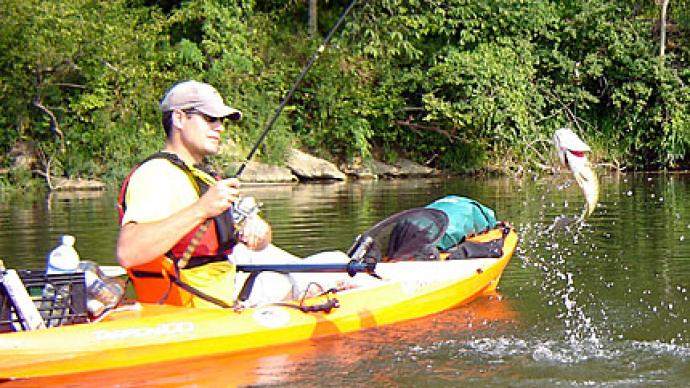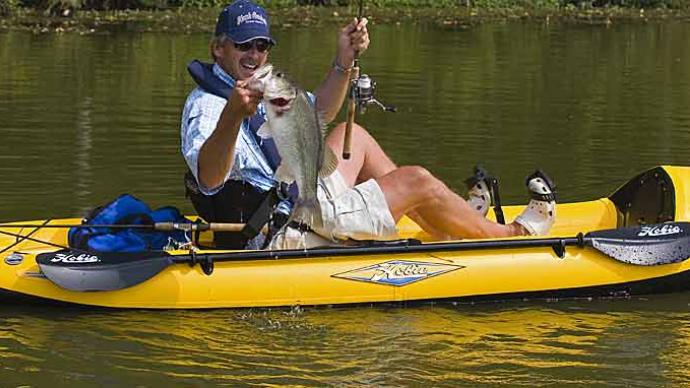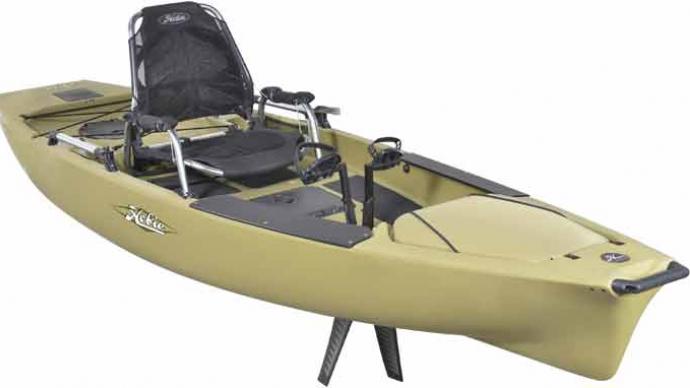Kayak fishing is all the rage right now. There are several reasons why. For one, kayaks are much cheaper than traditional fiberglass bass boats. Kayaks give anglers access to remote water. Today, kayaks can be rigged with just about any feature a die-hard bass-head can imagine.
The rising popularity of bass fishing from these portable watercraft has resulted in scads of articles written about how to set up a perfect fishing kayak and what types of accessories will or will not help you load the boat once you’re out on the water.
What needs to be included, though, is an in-depth discourse on the mechanics of actually fishing out of a kayak. The bottom line is – it’s different than fishing out of a boat. You’re closer to the water and sitting down. You are less stable. You are at the mercy of the wind and current and have different fishing gear at your disposal - all factors that require a little different approach than fishing from a boat.
To address some of those challenges, we put together this Guide To Fishing From A Kayak – from mastering boat control to casting and reeling mechanics.

1. Learn To Cast One Handed
This may be the most challenging adjustment for anglers accustomed to fishing from the bank or the stable front deck of a boat. Even the most stable kayaks don’t have much room between the sitting surface and the water – making the standard two-handed windup cast a dicey proposition. Experienced kayak anglers cast one-handed most of the time, with either baitcasting or spinning tackle, so it’s important to gear up accordingly. Instead of the super heavy flipping stick and 1-ounce jig, maybe opt to fish with lighter combos and more finesse tactics. The last thing you want to do is get too into a windup and tip your yak from a deep cast.

2. Master The One-Handed Paddle
Like the one-handed cast, efficient kayak angling requires skill in handling a paddle with one hand. Paddling a kayak is simple with two hands, as the rhythm comes easily to even the least experienced anglers and the least coordinated of humans. But what do you do when you’re fighting a fish with one hand, and you’ve got to steer your boat back upstream to get on the other side of a laydown or avoid an overhanging branch? You’ll have to navigate with your off-hand while not letting your fish off the hook. Practice locking the shaft of your paddle along one forearm, which anchors it along your arm, and allows you to use it more like a canoe paddle. Lock the shaft into your opposite-handed forearm, so you can effectively fight the fish with the other.
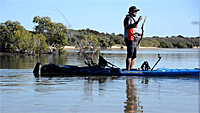
3. Use Your Feet
This might seem weird, but you’d be surprised how often experienced kayak anglers use their feet in some way while fishing. If your boat is narrow enough, you can use them as rudders to steer your drift on rivers, and they work as great anchors when fishing rip rap, laydowns, and other shallow areas – stick a foot out and hold on to the log until you’re done fishing the hole. Feet are also great for re-directing the boat from a stump, log, or other obstacles while your hands are busy fighting a fish. Get those toes ready to get wet, and wear shoes you are comfortable soaking. Putting your feet down is a stellar way to help you catch that lunker bass.
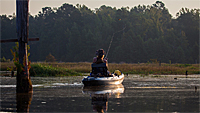
4. Cast To Steer
Baits that offer resistance, like crankbaits, spinnerbaits, and chatterbaits, can be used to help steer the boat. If you’re fishing a crankbait from a lightweight kayak, you’ll quickly realize that the simple resistance of reeling in the bait will pull your boat in the direction you’re casting. Use this to your advantage, and make casts in specific directions to subtly adjust your boat’s position. When the current is light, and the bait is heavy, you can use this as your primary steering method to drift along whatever area you are targeting.
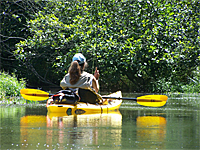
5. Utilize Eddies
You might think the current is a nightmare to fish in a kayak, but that’s far from the truth – provided you know how to use it to your advantage. Most kayaks are short and light enough to sit entirely in an eddy, preventing the boat from moving downstream and allowing you plenty of time to fish the corresponding current seam thoroughly. To maximize this, go past the spot you want to fish, tuck into the eddy behind it, and fish until your heart’s content – without even having to paddle. Eddies are familiar hiding places for all fish species, especially common stream dwellers like trout and smallmouth bass. Hide out in an eddy, cast into a spot they’d likely be lingering to strike, and get ready for a fight.
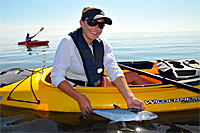
6. Don’t Be Afraid To Anchor
Although cumbersome, anchors have a place in the kayak fishing arsenal. This is particularly true on lakes when it is windy or in areas offshore where you want to stay in one particular area. For most kayak models, a 2-4 pound claw anchor is more than sufficient. Be careful anchoring in the current. If something happens, the current can push the whole boat underwater. Most river kayakers use a quick-release clevis on their anchors if they anchor at all.

7. Hug The Shoreline
When it’s windy or paddling up-current, it takes a lot of effort to make any headway, much less fish. In these situations, use the minimal draft of your kayak to your advantage. Instead of paddling right down the middle of the river or lake, get as shallow as you can. The current is weaker in super skinny water, and wind and waves are mitigated by shoreline vegetation and structures. Head toward the shore of a lake, along banks and cutlines, or hug tight to a point in the lake and cast outwards, barely off the bank. You’ll paddle more efficiently and have much more energy once you get to your honey hole.
There are several differences between boat, bank, wade, and kayak fishing. All have their time and place, and we’d all love a boat, but kayak fishing can be one of the more cathartic and rewarding ways to spend a day. Just you, your yak, your fishing gear, and the water. That simplistic nature can also make it difficult. Take into account all of these tips, from hugging the shore to grabbing stumps with your feet, and maximize your success on the kayak. Once you’ve mastered these seven kayak fishing tips, you will be a master on the water, fishing laps around everyone on the bank and the boat!


